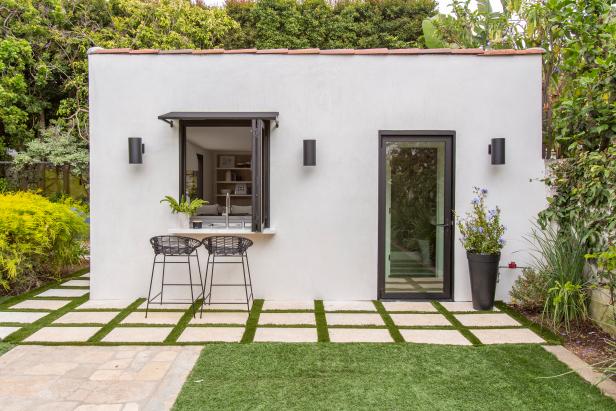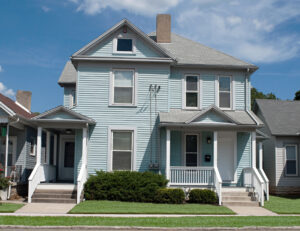About ADUs
What are ADUs?
An accessory dwelling unit (ADU), also known as a “mother-in-law” or “granny” flat, is an attached or detached residential dwelling unit placed on the same lot that is zoned for single-family, multi-family, or mixed-use/residential. An ADU provides complete independent living facilities for one or more persons. This includes permanent provisions for living, sleeping, eating, cooking, and sanitation, all on the same parcel as the primary, single-family dwelling/multi-family unit lot/or mixed-use/residential property. Each ADU has its own separate entrance, a kitchen, a bathroom and sleeping space.
ADU laws began to be created in 2017 (and have continued to be improved upon in subsequent years) by the State of California to provide new housing opportunities within existing neighborhoods. The additional units help diversify the market for renters and can provide supplemental income for homeowners. The City must abide by the State’s laws, but they can add items related to public health and safety for all. The City created its own Ordinance in December 2021 (Ordinance No. 1666) which has created more flexibility for Laguna homeowners. An ADU increases the value of the property and increases the amount of affordable housing in Laguna Beach. A property can have both an ADU and JADU on the property.
 A stand-alone backyard ADU example, less than 800 square feet in size.
A stand-alone backyard ADU example, less than 800 square feet in size.FOUR TYPES OF ADUs
There are four types of ADUs. All are legal in Laguna Beach, but the size of your yard, setbacks, slopes within your lot, and other conditions may limit the choices you have. All require independent entryways and may be no larger than 18′ in height. There is an exception: If a unit is attached to the house, it may be as high as 25′ or the maximum height of the underlying zone, whichever is lower.
Detached ADUs/Stand-alone/New square footage creation on a lot: Detached ADUs would not be located in the house or within the existing footprint. They can be located in the back, front or side yard. The size of a new, free-standing ADU typically ranges from 400-800 square feet, although larger units are possible — up to 1,000 square feet for a 2-bedroom. Stand-alone ADUs tend to be the most expensive approach and require the largest yard space to conform with the State’s rules regarding setback and building separation requirements. Stand-alone units require that there are solar panels on either the ADU or main house. The greatest benefits are that higher rents can be charged and this concept provides more privacy for all parties. One parking space per ADU would need to be created on the property, but there are exceptions: for example, if the property is located within .5 mile walking distance of a public transportation stop, no new parking would be required. Note that in Laguna, the City no longer has a regular bus system or trolley for the neighborhoods, so the bus stops would be OCTA stops on Coast Highway or Laguna Canyon Road. The other possible way to avoid creating new parking on a stand-alone or attached ADU is if there is ample parking on the street which could accommodate the needed parking.
Attached ADUs/Addition: An ADU can be created by adding more square footage to an existing house or attached garage. The unit could be on the ground level, a 2nd level of the house — or over an attached garage. These attached units are required to be individual living quarters. An attached ADU can provide more privacy than an interior conversion. It also may be possible to extend the existing home’s plumbing and electricity rather than creating new extensive utility connections, although the homeowner may want to add a sub-panel for electric service for a 2nd unit if you wish a renter to pay the electric bill for that unit only. They typically require land area, but less than a stand-alone unit. The size of the units can be 50% of the floor area of the existing primary dwelling unit up to 850 square feet max for a one bedroom or 1000 square feet max for a 2 bedroom. The attached ADU can be up to 25′ high or the maximum height of the underlying zone, whichever is lower. An additional parking space will need to be created on site, unless the property is located within .5 miles of a transit stop. If you have room in your driveway for tandem parking, the parking can be created there and it does not have to be covered. The City Council approved allowing no parking requirement in areas beyond .5 mile walking distance of a transit stop, The other possible way to avoid creating new parking on a stand=-alone or attached ADU is if there is ample parking on the street which could accommodate the needed parking.
Garage or Carport Conversion: An existing attached or detached garage or carport may be converted into an ADU. It is created within the existing footprint. The California Coastal Commission is now requiring that these conversions replace the parking lost from the garage on the property. A long driveway which can accommodate the new parking requirement may be used to meet the code, and it does not have to be covered.
Interior Conversion and JADU: There are 2 types of interior conversions. The first type can be walled inside the house and can be any size. It can also be a basement within the 4 walls of the house. In all cases there must be a legal finished floor to be called a “conversion”. It requires a full kitchen including oven. It is important to note that if the existing space did not have a legal floor in the converted space being proposed, it must be treated as an attached ADU.
The second type is a Junior ADU, (typically called a JADU). It is created within the walls of an existing house or attached garage and the size of this unit would be between 150 – 500 square feet and have a kitchenette. An oven is not required. A bathroom in the main house may be shared with the JADU. if there is a connecting door between the inside of the JADU to the house. The conversion would be permanent and have a separate entrance. Note that a deed restriction would need to be recorded/filed with for a junior ADU as the use runs permanently with the land. The deed restriction states that a “JADU has been created on the property that requires the owner to live on the property and continue to be set up in the nature of a rental unit.” No new parking needs to be created for the interior JADU or converted interior units, however JADUs that are created using the garage must have replacement parking on site, per recent rulings from the California Coastal Commission.
The State Requires that Laguna Beach Allow ADUs to be Built With Minimal Approval Processes
Typically, in the past, when a Laguna Beach homeowner wanted to build an addition to their house, they had to go through a lengthy entitlement process. This would have included appearing in front of the Design Review Board where neighbors were provided the opportunity to express their support or concerns regarding the project. In the case of ADU and JADU applications, the homeowner does NOT have to appear in front of the City’s Design Review Board. If the application is complete, the State code states that the City must approve the project within 60 days. (Note: rarely is an application complete, as determined by the City, therefore multiple changes to plans often occur throughout the planning and building review processes.)
 A creative example of an ADU built inside the existing house (less than 500 square feet; independent entrance).
A creative example of an ADU built inside the existing house (less than 500 square feet; independent entrance).Some specific key criteria
When you contact Laguna ADU, LLC, we will meet with you at your home at no cost in order to help you determine if an ADU is possible – and to help you to identify the best location(s) for an ADU. We will provide you with all the basic criteria required that allows you to create an ADU on your property. Of course, the most expeditious and affordable approach would be to create a unit within the footprint of your existing house or in a garage that already exists.
Some specific criteria outlined by the State of California includes:
- Height: An ADU cannot be higher than 18′ high unless it is an attached ADU – which can be up to 25′ high or the height of the underlying zone, whichever is lower.
- Size:
- Detached (new stand-alone unit):
- 1 bedroom up to 850 square feet max
- 2+ bedrooms up to 1,000 square feet max
- Attached ADU: whichever is the lower of the following:
- 50% of the floor area of the existing primary dwelling
- a one-bedroom at 850 square feet max
- two or more bedrooms at 1,000 square feet max
- Basement conversion: Must already have a “finished” floor and walls — and size is not limited.
- Garage conversion: Minimum of 150′ square feet. Same size as existing garage.
- Interior conversion: No limit in size unless it is a JADU.
- JADU: Minimum of 150 square feet and maximum of 500 square feet. A JADU is typically inside the existing walls of the house or attached garage.
- Detached (new stand-alone unit):
- Setbacks:
- Front: applicable City zoning/building standards (20′ street setback in front). The City is making some exceptions for a stand-alone unit to have a lower front yard setback if there is not another location on the property to build a stand-alone unit.
- Side & Rear: A minimum of 4 feet
- Parking:
- Regular-stand-alone ADUs or additions : One space per ADU which can be a tandem spot on an existing driveway and can be tandem. There are exceptions, such as if the new ADU will be located within .5 miles of a public transit stop. (Note that the City has discontinued the neighborhood bus and trolley service, so those can’t be used to meet the criteria.) Also, the City recently approved allowing the parking to be met if you live on a street where there is ample parking. New curb cuts and driveways are not permitted.
- Interior conversion No parking required on an interior conversion if it is within the existing legal square footage of the house. :
- Garage Conversions: Parking is now required if you create a garage conversion. The Californis Commission is required that lost parking must be replaced for these types of conversions ON-SITE. These spaces can be in the driveway and do not have to be covered.
- JADUs: No new parking requirements, unless the JADU is in a garage. The California Coastal Commission is requiring garage conversions to replace the lost parking space(s) from the garage on site. This can be on a long driveway (tandem parking is OK), and it does not have to be covered.
What are the Benefits of Creating an ADU or Junior ADU on your property?
- Increase property value.
- Create rental income.
- Provide a space for a caretaker.
- Create a mother-in-law unit.
- Create a unit for a grown child.
- Add to the State of California’s (and Laguna’s) rental housing stoc
Click here to see all the updated California Laws for ADUs.